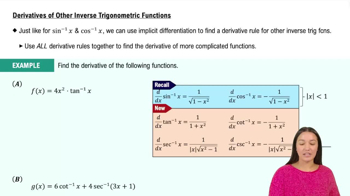Here are the essential concepts you must grasp in order to answer the question correctly.
Derivative
The derivative of a function measures how the function's output value changes as its input value changes. It is defined as the limit of the average rate of change of the function over an interval as the interval approaches zero. In calculus, the derivative is often denoted as f'(x) or df/dx, and it provides critical information about the function's behavior, such as its slope and points of tangency.
Recommended video:
Inverse Trigonometric Functions
Inverse trigonometric functions, such as sin<sup>-1</sup>(x), are the functions that reverse the action of the standard trigonometric functions. For example, sin<sup>-1</sup>(x) gives the angle whose sine is x. These functions have specific domains and ranges, and their derivatives can be derived using implicit differentiation or known derivative formulas, which are essential for evaluating derivatives involving these functions.
Recommended video:
Derivatives of Other Inverse Trigonometric Functions
Chain Rule
The chain rule is a fundamental technique in calculus used to differentiate composite functions. It states that if a function y = f(g(x)) is composed of two functions, the derivative can be found by multiplying the derivative of the outer function f with the derivative of the inner function g. This rule is particularly useful when dealing with functions like sin<sup>-1</sup>(2x), where the inner function (2x) must be differentiated alongside the outer function (sin<sup>-1</sup>), requiring careful application of the chain rule.
Recommended video:
 Verified step by step guidance
Verified step by step guidance Verified video answer for a similar problem:
Verified video answer for a similar problem:



 7:26m
7:26m